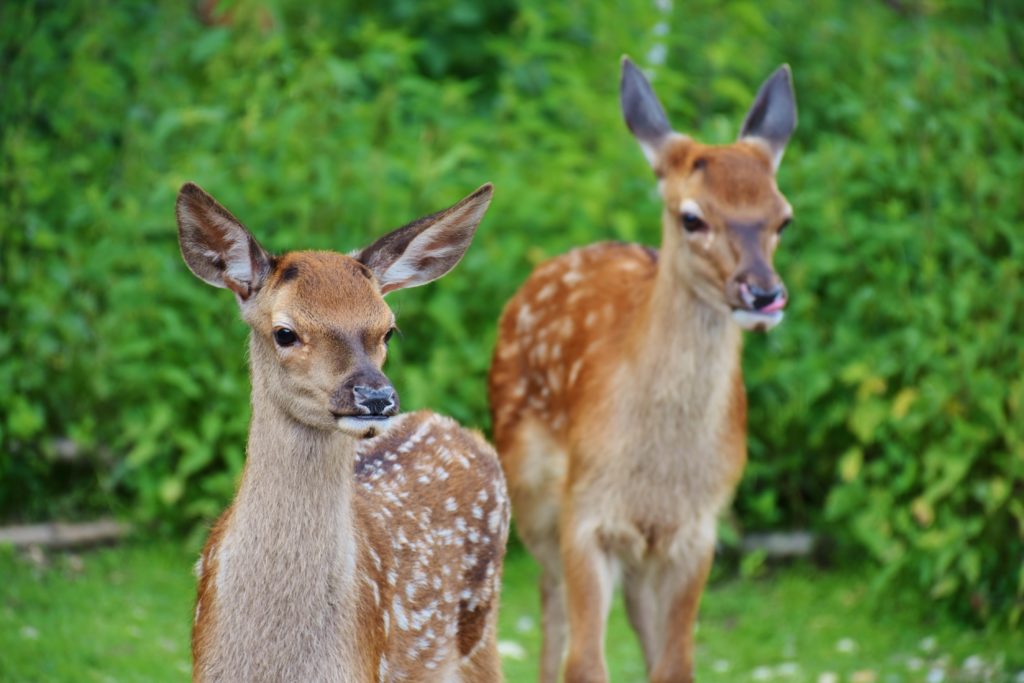Deterring Deer

After my blog post about deterring rabbits, I was immediately asked about deer. Deer can be a big problem. I think of them as the adolescent boys of garden pests. They will eat you out of house and home in the blink of an eye, and still be hungry for more. Unfortunately, they are also plentiful in southern Wisconsin. So here is my list of ways to keep those deer from eating you out of your house and home – or at least your garden. Keep in mind that no method is guaranteed.
- Build a tall fence. Eight feet tall, at the very least. Ten is better. Deer can jump that high. If you live in a city, zoning codes may not allow a fence taller than 6 feet. In that case, a six-foot fence is better than nothing, especially if the deer can’t see what is on the other side, so go with wood or vinyl instead of chain link. If they see something tasty, they will jump a 6-foot fence. Or you can go the double fence route. Build two fences about 4-5 feet tall and 5 feet apart, forming a double perimeter around your garden. Deer don’t have good depth perception and won’t attempt to jump both. If you are really serious about keeping deer out, an electric fence will work, but remember it can be dangerous to children and other animals and need to be well maintained at all times. It may not be the best choice.
- If you don’t want or can’t have a big fence, another alternative barrier is an 8-foot-wide perimeter of large rocks. Hooved animals have a hard time walking on rocky surfaces and won’t be able to jump over them.
- Use a deterrent. Commercial options like Liquid Fence, Bobbex, Deer Away, and others are available online or in most hardware stores. Check to see if they are safe for pets and small children, and that they are food safe if you intend to use them on vegetables or fruits. And remember to use them only as instructed. Most likely these will need to be reapplied regularly, especially after it rains. Non-commercial deterrents include human hair, bars of strongly scented soap strung on posts or wires, bloodmeal, or animal urine. Getting a dog may help. Motion detected sprinklers are another option that may work.
- Plant things deer don’t like to eat. Generally speaking, deer don’t like leaves that are fuzzy, prickly, or leathery in texture, or plants that have a strong scent or are toxic. Very hungry deer will eat whatever is available, though, and deer are individuals. Just like us they have varying favorites. Pleasant Prairie Greenhouse carries the following “deer resistant” plants, among others:
- Annuals: ageratum, alyssum, begonias (dragonwing, tuberous, or wax), dahlia, datura, dusty miller, geranium, lantana, marigold, nicotania, snapdragons, statice, strawflower, and flowering vinca.
- Perennials: ajuga, allium, artemisia, astilbe, balloon flower, baptisia, bee balm, bergenia, bleeding heart, brunnera, clematis, columbine, coneflower, threadleaf coreopsis, daffodils, ferns, foxglove, ornamental grasses, geum, ginger, Jack in the pulpit, Joe pye weed, lady’s mantle, lamium, lamb’s ear, lavender, liatris, lupine, nepeta, pachysandra, peony, poppy, pulmonaria, salvia, sea holly, shasta daisies, sweet William, and yarrow.
- Herbs: dill, mint, oregano, sage, and thyme.
- Trees and Shrubs: birch, dogwood, forsythia, honey locust, juniper, maple, potentilla, oak, spirea, Korean spice viburnum, and weigela.
- Vegetables: asparagus, carrots, eggplant, garlic, leeks, onions, peppers, and tomatoes.
It is best to use several of these strategies together. Hopefully they will help reduce the damage deer cause in your garden. Good luck and happy gardening!
